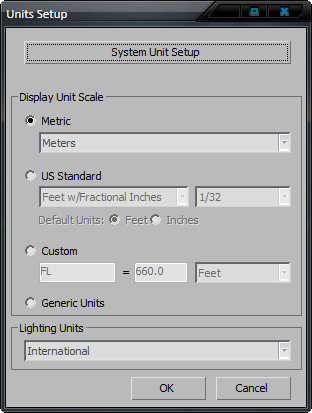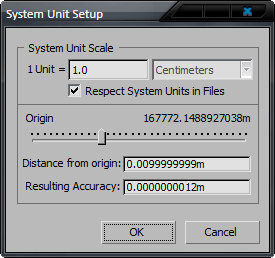The CryENGINE 3 uses a metric scale to represent objects, distance, and size. It is important to keep this in mind when making photo-realistic assets. To make objects accurate to real-world measurements the unit setup in your DCC package must be set up to match the scale in the engine.
To prepare yourself for modeling objects for use in CryENGINE, 3ds Studio Max must be open.
Different game engines use a different scale to represent objects; in our case let's set up our 3ds Max application to work with CryENGINE 3:
- Along the top menu bar of 3ds locate Customize. Click it and select Units Setup from the list.

- In Unit Setup, change the Display Unit Scale to Metric Meters.
- Next, click System Unit Setup.

- From here change your System Unit Scale to 1 Unit = 1.0 Centimeters.
- Click OK to go back into your 3DS Scene.
Now that the scale and unit size have properly been set up, we can now accurately represent our model in 3ds Max the way it is meant to be rendered in CryENGINE.
It is common for some artist to load a scale human model when making some assets to maintain believability.
One of the major advantages of using metric with 3ds is that it makes all unit inputs and calculations, for example, when creating primitives, match the metric values.
Unit setup can be a bit broader than just setting metric units. To learn about techniques used when working in metric scale within 3ds as well as some measurement references, continue to the following section.
Depending on the type of asset you may be creating, it is recommended to adjust the view port grid to a suitable setting.
Click the Tools menus at the top of 3ds and then go to Grids and Snaps and finally select Grids and Snaps Settings.
In these settings, you can change the Grid Spacing to other values. For large objects using a grid spacing of 1 meter is recommended. For smaller objects 1 cm is usually sufficient.
The following reference measurements were originally created for the game Crysis, but are useful as a guide for creating new assets:
- Table Height (top of table) = 75 cm
- Seat height (top of chair, seat) = 46 cm
- Stairs height = power of 75 cm (150 cm, 225 cm, 300 cm, 375 cm, 450 cm)
- Stair steps = 18.75 cm (4 steps will sum up to 75 cm)
- Boxes = 60cm x 40cm x 40cm
- Hide Objects (which AI are prone to hide behind) = objects that are smaller than 120 cm
- Hide Objects (which AI crouch to hide behind) = objects that are bigger than 120 cm
- Hide Objects (which AI stand to hide behind and strafe left/right to leave cover) = objects that are bigger than 180 cm
- Jump over Objects (standing, without hand) = 30 - 50 cm high
- Jump over Objects (running jumps) = 50 - 100 cm high
- Jump over Objects (sideways, using hand) = 120 - 150 cm high
